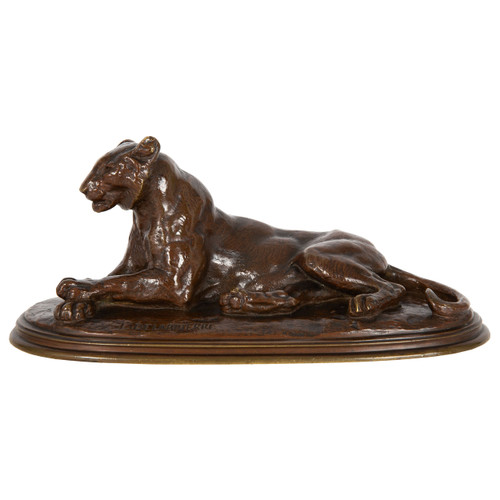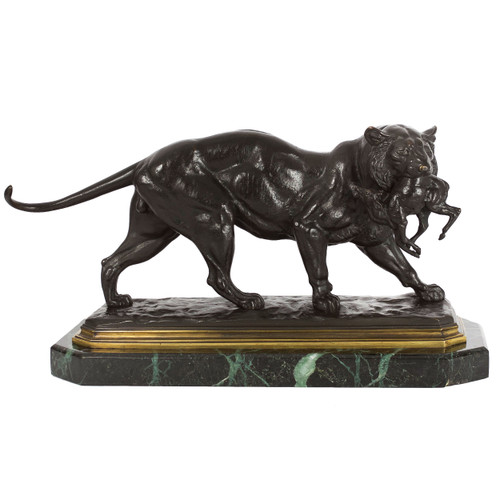-

-

Delabriere, Paul Edouard
Tiger Carrying a Gazelle | Paul-Edouard Delabrierre [after]
Regular Price: $3,250.00 -

Delabrierre, Paul Edouard
Very little is known about the life of animal sculptor Paul-Edouard Delabrierre beyond the extensive body of work he left behind. He was born in Paris on March 29th of 1829 and studied under the painter Jean-Baptiste Delestre. Following closely in the steps of Antoine-Louis Barye, though doing less to push the boundaries of Realism than his contemporaries, he produced a broad body of work almost exclusively focused on animal subjects, these with more of an eye towards the anecdotal moments in nature versus an emphasis on the anatomical exactness of the animals. A survey of his work will show a distinct preference for hunting scenes with men and animals over domestic scenes.
Almost invariably, his Realism studies are more successful than the works he authored in the Romantic taste and remain well sought after by collectors of animal sculpture. Both in finish and form, the Realist sculptures by Delabrierre tend towards the exceptional and place him among the best of his Animalier contemporaries. The anthropomorphic attributes in his Romantic works were the academic standard for animals prior to the emergence of the then controversial Animalier school in the middle of the 19th century. He made his debut at the Salon in 1848 and continued exhibiting regularly through 1882 - a list of the 70 models he presented at Salon are available in Lami's Dictionnaire. His most important public work is the large composition in stone L'Equitation, designed in 1857 as a pediment for the facade of the Palais du Louvre. His 1858 study of Indian Panther Devouring a Heron (Panthére de l'Inde et Héron) is preserved in the permanent collection of the Museum at Amiens.
Literature & Further Reading:
- E. Benezit Dictionary of Artists, Vol. IV, Gründ, 2006, p. 599
- Dictionnaire des Sculpteurs, Stanislas Lami, vol. II, p. 140-142 (including one of the most extensive listings of his exhibitions at Salon)
- Bronze Sculptures of "Les Animaliers", Jane Horswell
- Bronzes of the Nineteenth Century: Dictionary of Sculptors, Pierre Kjellberg, p. 276-78
- Art Bronzes, Michael Forrest, p. 474
- The Animaliers, James Mackay, p. 59-60
- Les Bronzes Animaliers, De l'antiquité à nos jours, Jean-Charles Hachet, Editions Varia, 1986, p. 127-8
